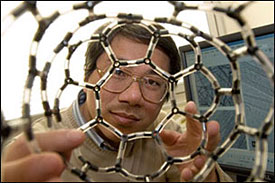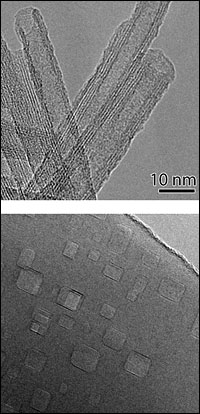
Nanorods for Better Sunscreen
UPTON, N.Y., Sept. 11, 2007 -- New ways to make or modify nanorods and nanotubes of titanium oxide, a light-absorbing material used in a variety of industrial and medical applications, may lead to improved catalysts for hydrogen production, more efficient solar cells, and more protective sunscreens.
The research was recently published in two papers. In the first study, the Brookhaven National Laboratory scientists enhanced the ability of titanium oxide to absorb light.

Wei-Qiang Han
"Titanium dioxide's ability to absorb light is one the main reasons it is so useful in industrial and medical applications," said Wei-Qiang Han, a scientist at Brookhaven's Center for Functional Nanomaterials (CFN) and lead author on both papers. It is used as a photocatalyst for converting sunlight to electricity in solar cells and also has applications in the production of hydrogen, in gas sensors, in batteries, and in using sunlight to degrade some environmental contaminants. It is also a common ingredient in sunscreen.
Many scientists have explored ways to improve the light-absorbing capability of titanium oxide, for example, by "doping" the material with added metals. Han and his coworkers took a new approach. They enhanced the material's light-absorption capability by simply introducing nanocavities, completely enclosed pockets measuring billionths of a meter within the 100-nanometer-diameter solid titanium oxide rods.
The resulting nanocavity-filled titanium oxide nanorods were 25 percent more efficient at absorbing certain wavelengths of ultraviolet A (UVA) and ultraviolet B (UVB) solar radiation than titanium oxide without nanocavities.
"Our research demonstrates that titanium oxide nanorods with nanocavities can dramatically improve the absorption of UVA and UVB solar radiation, and thus are ideal new materials for sunscreen," Han said.

Transmission electron micrographs of nanocavity-filled titanium oxide nanorods (bottom) and iron-doped titanate nanotubes (top). Both are being investigated as photocatalysts for reactions to produce hydrogen gas. The improved light-absorption of the nanocavity-filled nanorods also makes them ideal new materials for sunscreen. (Image courtesy of DOE/Brookhaven National Laboratory)
The cavity-filled nanorods could also improve the efficiency of photovoltaic solar cells and be used as catalysts for splitting water and also in the water-gas-shift reaction to produce pure hydrogen gas from carbon monoxide and water.
The method for making the cavity-filled rods is simple, said Han. "We simply heat titanate nanorods in air. This process evaporates water, transforming titanate to titanium oxide, leaving very densely spaced, regular, polyhedral nanoholes inside the titanium oxide."
In the second paper, Han and his collaborators describe a new synthesis method to make iron-doped titanate nanotubes, hollow tubes measuring approximately 10 nanometers in diameter and up to one micrometer (one millionth of a meter) long. These experiments were also aimed at improving the material's photoreactivity. The scientists demonstrated that the resulting nanotubes exhibited noticeable reactivity in the water-gas-shift reaction.
"Although the activity of the iron-doped nanotubes was not as good as that of titanium oxide loaded with metals such as platinum and palladium, the activity we observed is still remarkable considering that iron is a much less expensive metal and its concentration in our samples was less than one percent," Han said.
The scientists also observed interesting magnetic properties in the iron-doped nanotubes, and will follow up with future studies aimed at understanding this phenomenon.
The research was funded by the Office of Basic Energy Sciences within the US Department of Energy's Office of Science. The two studies are available online, in Advanced Materials (Aug. 22), and the Journal of Physical Chemistry (Sept. 8).
For more information, visit: www.bnl.gov
Published: September 2007